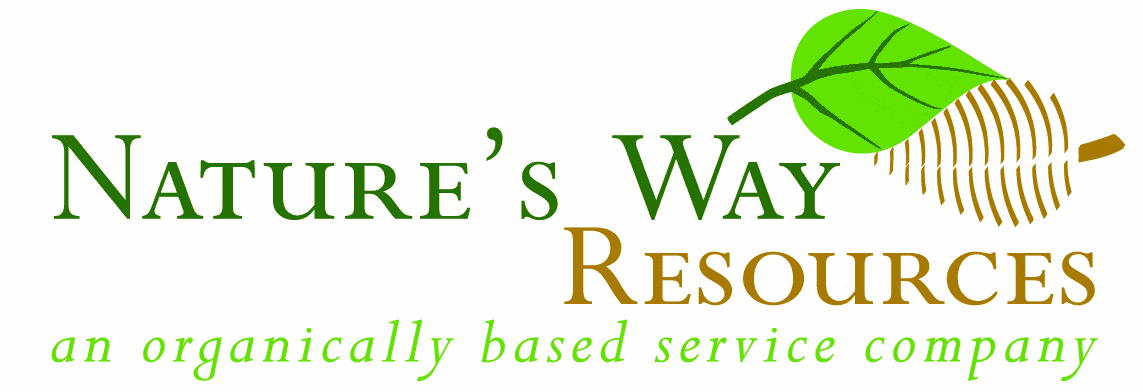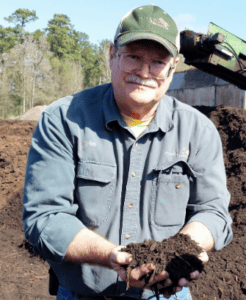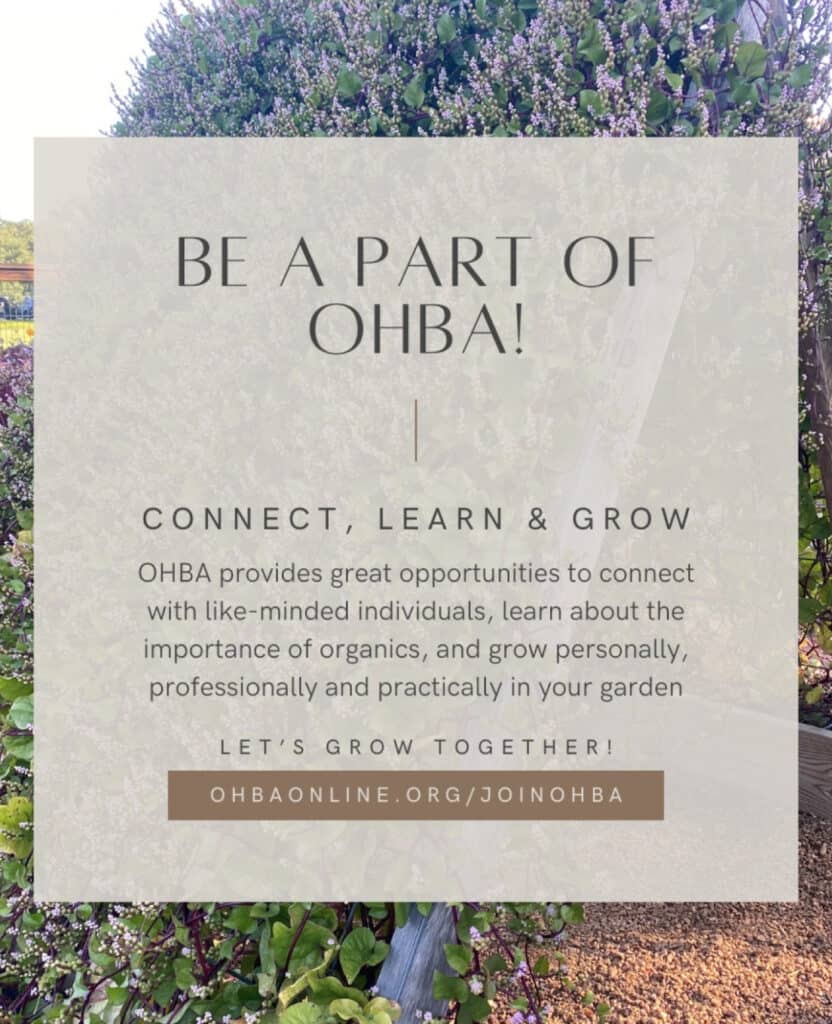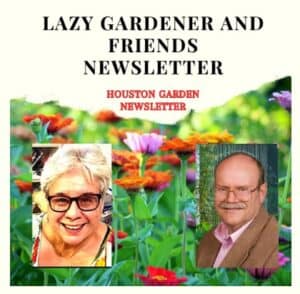 Nature’s Way Resources is proud to produce & email you this free weekly newsletter. We have no ads, but sponsors do graciously help support this project as a public service. Please note their names below & show your gratitude for this free service by patronizing their businesses! To become a sponsor, call (936) 273-1200
Nature’s Way Resources is proud to produce & email you this free weekly newsletter. We have no ads, but sponsors do graciously help support this project as a public service. Please note their names below & show your gratitude for this free service by patronizing their businesses! To become a sponsor, call (936) 273-1200
Nature’s Way Resources owner John Ferguson, “The Lazy Gardener” Brenda Beust Smith and Pablo Hernandez welcome your feedback and are so grateful to the many horticulturists who contribute their expertise
Click here to join our email list
CLICK HERE for PDFs OF PAST LG&F NEWSLETTERS
“Gardeners, thou name must be “Patience”!
— Yours Truly, one morning when I looked
out my den window and saw . . .
BY BRENDA BEUST SMITH
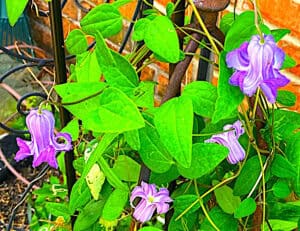 CHEER WITH ME! SHE’S BACK! When we first moved to Aldine in 1967, our new home was in a heavily wooded area on Greens Bayou. Few houses, lots of deep ditches. I knew zero about gardening. Across our street, atop an especially deep ditch, I spied tiny, beautiful bell-shaped, lavender flowers on incredible delicate vines, one of the first wildflowers I saw every spring thereafter.
CHEER WITH ME! SHE’S BACK! When we first moved to Aldine in 1967, our new home was in a heavily wooded area on Greens Bayou. Few houses, lots of deep ditches. I knew zero about gardening. Across our street, atop an especially deep ditch, I spied tiny, beautiful bell-shaped, lavender flowers on incredible delicate vines, one of the first wildflowers I saw every spring thereafter.
Dug up a few, planted in my yard. Numerous floods, including Harvey’s 6′ flood (took our Aldine home of then 50+ years — literally!). I tried to rescue as many of my plants as could, including this Clematis texensis (pictured). Very few transplants survived at our new home but my precious Clematis texensis is fine and, as you can see, after 7 years is still blooming beautifully every spring!
 OUR SPOTLIGHT ARTICLE below should come as good news for all ‘lazy gardeners’ wondering if they should start planting more edibles. Angela Chandler has been sharing practical, doable gardening advice for as long as I can remember. Love her “Garden Academy” focus on “Edible Urban Homesteading”!
OUR SPOTLIGHT ARTICLE below should come as good news for all ‘lazy gardeners’ wondering if they should start planting more edibles. Angela Chandler has been sharing practical, doable gardening advice for as long as I can remember. Love her “Garden Academy” focus on “Edible Urban Homesteading”!

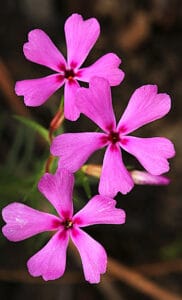 SATURDAY’S “FULL PINK MOON” (Apr. 12), (which for us may be golden or yellowish-white) is said to trigger instant calm, reducing stress. It’s actually called ‘Pink Moon” because of the wide varieties of wild pink phlox bloom now blooming in so many states this time of year. One of our earliest spring wildflowers, they do well in home gardens, sun-to- partial shade, fragrant, attract hummers & butterflies.
SATURDAY’S “FULL PINK MOON” (Apr. 12), (which for us may be golden or yellowish-white) is said to trigger instant calm, reducing stress. It’s actually called ‘Pink Moon” because of the wide varieties of wild pink phlox bloom now blooming in so many states this time of year. One of our earliest spring wildflowers, they do well in home gardens, sun-to- partial shade, fragrant, attract hummers & butterflies.
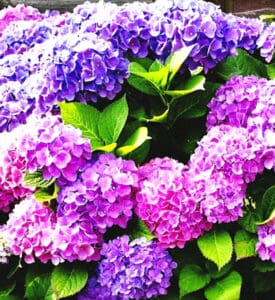 PLANTING HYDRANGEAS? We often talk about edibles being picky garden neighbors. Suzi J. asks to that true of flowers? It can be. Hydrangeas, eg, might pout if they have to share soil with anemones, daffodils, garlic, marigolds, roses, sunflowers, thyme, or many of their own hydrangea cousins, One thing to check if something dies and you know not why.
PLANTING HYDRANGEAS? We often talk about edibles being picky garden neighbors. Suzi J. asks to that true of flowers? It can be. Hydrangeas, eg, might pout if they have to share soil with anemones, daffodils, garlic, marigolds, roses, sunflowers, thyme, or many of their own hydrangea cousins, One thing to check if something dies and you know not why.
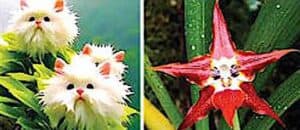
- KITTY-FACE ORCHIDS? Real? Or AI art? Galveston Orchid Society’s ERIN GRAHAM says there ARE ‘face orchids’ such as the Huntleya burtii at far right, a native of Central America . . .
. . . but she suspects the frequently-advertised one at left above has had more than a little AI (artificial intelligence) touch! Anyone who ordered one of these have a response?
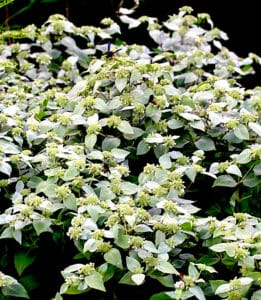 PERENNIAL PLANT ASSN.’s 2025 PLANT OF THE YEAR? CLUSTERED MOUNTAIN MINT (Pycnanthemum muticum) is said will grow in the Greater Houston area. It’s a vigorous, colony-forming herbaceous perennial that spreads by rhizomes but is not as aggressive as some of its mint family relatives. Also known as blunt mountainmint, or short-toothed mountainmint and is native to meadows and open woodlands.
PERENNIAL PLANT ASSN.’s 2025 PLANT OF THE YEAR? CLUSTERED MOUNTAIN MINT (Pycnanthemum muticum) is said will grow in the Greater Houston area. It’s a vigorous, colony-forming herbaceous perennial that spreads by rhizomes but is not as aggressive as some of its mint family relatives. Also known as blunt mountainmint, or short-toothed mountainmint and is native to meadows and open woodlands.
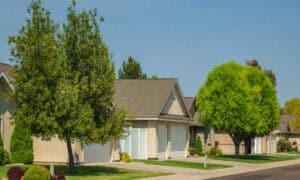 TREE TRAUMA STILL? If you’re like we are, you’re closely watching surviving trees, cheering on every new green leaf or needle. Log into Trees for Houston’s Resources for free helpful advice and to register for upcoming tree giveawaysI No drop-ins allowed.
TREE TRAUMA STILL? If you’re like we are, you’re closely watching surviving trees, cheering on every new green leaf or needle. Log into Trees for Houston’s Resources for free helpful advice and to register for upcoming tree giveawaysI No drop-ins allowed.
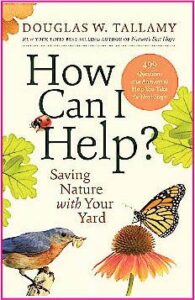 CLIMATE CHANGE HITS HOME: DOUG TALLAMY has become a household name among gardeners worried about how climate change is affecting our gardens and the way we do/don’t garden. His HOMEGROWN GARDEN organization Is now 36,000 members strong and growing in the U.S. & Canada. Doug’s latest book, ““How Can I Help?” focuses on climate change aspects we adults were seldom/never taught about biodiversity and “…how much we depend on it totally.”
CLIMATE CHANGE HITS HOME: DOUG TALLAMY has become a household name among gardeners worried about how climate change is affecting our gardens and the way we do/don’t garden. His HOMEGROWN GARDEN organization Is now 36,000 members strong and growing in the U.S. & Canada. Doug’s latest book, ““How Can I Help?” focuses on climate change aspects we adults were seldom/never taught about biodiversity and “…how much we depend on it totally.”
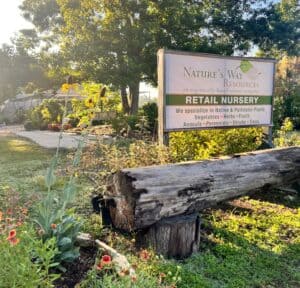 ATTN. GARDEN/PLANT GROUPS — Nature’s Way Resources offers free guided tours of NWR’s extensive nursery/soil/mulch facilities for garden clubs, plant societies and other plant-oriented, organized groups. As usual, NWR’s now-expanded meeting site is free to above groups. Reservations a must for both. Great time to visit!
ATTN. GARDEN/PLANT GROUPS — Nature’s Way Resources offers free guided tours of NWR’s extensive nursery/soil/mulch facilities for garden clubs, plant societies and other plant-oriented, organized groups. As usual, NWR’s now-expanded meeting site is free to above groups. Reservations a must for both. Great time to visit!
- SUBMITTING CALENDAR EVENTS?: These will be in next upcoming newsletter ONLY IF SUBMITTED IN OUR EXACT FORMAT they may be held until can be reformatted.
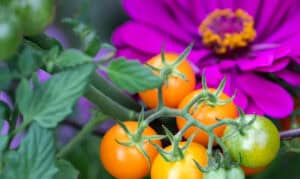 THE “GROCERY GARDEN”? YOU’RE ALREADY HALF WAY THERE!
THE “GROCERY GARDEN”? YOU’RE ALREADY HALF WAY THERE!
BY ANGELA CHANDLER
THE GARDEN ACADEMY
thegardenacademy.com
There is nothing more convenient than grocery shopping in your own front yard! You don’t have to dress up, put on your good shoes, or even start the car. And your HOA may never be the wiser.
Everyone wants to grow fruits and veggies that are nutrient dense, have never been exposed to synthetic chemicals, and are picked at the peak of ripeness. But some of us don’t have the room for a traditional veggie garden, much less a family orchard.
You can work a surprising number of vegetables, herbs, and fruits into your current ornamental garden without building a single square foot of new garden beds. You can do this without losing design aesthetic you have worked to achieve. It’s easier than you think, and works well with any style of garden you already have. In fact, there are a number of advantages to growing this way:
- Staggered production, suiting your cooking schedule
- Get in the seed habit, lowering food production cost
- Healthier soil – a diversity of plant roots supports a denser and more varied soil microbiome
- Garden in minutes a day
- No heavy tilling or bed preparation
- The whole family can get involved
- Fewer weeds – where there is a plant, there is no room for a weed – use veggies and herbs as ground covers
- Fewer pests – growing edible plants in your ornamental landscape camouflages them from migrating pests
Here is an easy way to get started:
- Get a bundle of marking flags from your local hardware or big box home store.
- Walk your garden looking for spots you could fit something in and set a marking flag in the spots.
- Make a list of the flags, noting the daily sun exposure of each – some veggies and herbs will be quite happy in partial or light shade.
- Take this list with you to the nursery, or your favorite seed supplier – don’t forget feed stores!
- Prepare the soil in each spot by adding compost and your favorite slow release organic fertilizer.
- Plant a few transplants or seeds in the prepared soil and water well. You will be harvesting veggies soon!
You will be surprised just how easy it is to turn your current landscape into your personal green grocery without losing any of your curb appeal.
John’s Corner
NEWS FROM THE WONDERFUL WORLD
OF SOIL AND PLANTS
Subject: regenerative agriculture toxic food additives
The organization Regeneration International has a short video on how we can quickly prevent climate change. Go to their website and click on video “Soil Organic Matter”.
After watching the video, you will have a better appreciation of the book below.
Book review:
The Regenerative Agricultural Solution, A Revolutionary Approach to Building Soil, Creating Climate Resistance, and Supporting Human and Planetary Health, Ronnie Cummins and Andre Leu, Chelsa Green Publishing, 2024, ISBN: 978-1645022695
The book has many examples of how farmers quickly improved their soil by sequestering carbon from the air. As a side benefit, they produced healthier and more nutritious plants.
By using these techniques in our yards and gardens we get the same benefits, and we are part of the solution. These methods are all based on modern biological methods we call organic gardening and farming.
Today’s toxic chemical rescue agriculture contributes many times more to climate change than the petroleum industry. To reverse climate change we need to reform agriculture.
From the publisher:
“Read this book to understand why you should care about regenerative agriculture. Until the public is better-informed and insists on sweeping changes to current agricultural policy . . . we will continue to degrade our planet and destabilize our climate. Leu and Cummins, through inspiring stories and solid science, show just how quickly we could turn that around.”—Allan Savory, president, Savory Institute; chairman, Africa Centre for Holistic Management
Is it possible that the solution to the global climate emergency lies in a “waste” agricultural product?
The best-kept secret in today’s world is that solutions to some of our most pressing issues—food insecurity, deforestation, overgrazing, water scarcity, rural poverty, forced migration—lie in adopting, improving, and scaling up organic and regenerative agriculture best practices.
The Regenerative Agriculture Solution starts with the story of how two brothers—Jose and Gilberto Flores—are at the leading edge of this approach, pioneering the use of the previously discarded leaves of the prodigious agave plant to regenerate agricultural soils, reduce erosion, and improve water capture.
When Ronnie Cummins, the cofounder of Organic Consumer Association (OCA) and Regeneration International, met the Flores brothers in 2019 and witnessed their revolutionary agave agroforestry system, he knew they were onto something important.
Cummins had spent decades studying the potential and pitfalls of organic and regenerative agriculture and knew best practices when he saw them. He started to write a book about Flores’s brother and other visionary people, such as Dr Vandana Shiva, Allan Savory, and John Liu, who started landscape-scale regeneration projects. The scientific data was even more convincing, suggesting that these projects—and others like it—could revolutionize how we understand the climate catastrophe.
Sadly, Cummins passed away in April 2023, in the midst of working on the book. Not to leave this work unfinished, Ronnie’s widow and OCA cofounder, Rose, called on their friend, colleague, and collaborator, Regeneration International’s cofounder André Leu, to complete the work and place the Flores brothers’ breakthroughs in the broader context of regenerative agriculture solutions to the world’s many interlocking ecological crises.
The result is The Regenerative Agriculture Solution, a book that shows how regenerating our forests, rangelands, and farming ecosystems can cool our planet, restore the climate, and enrich our communities.
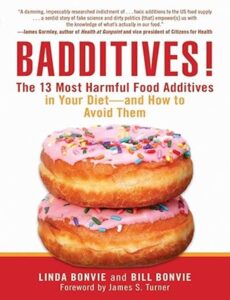 Book review: This is another book I finished this week on food additives that are found in most types of processed food. These toxic chemicals are allowed by a corrupt FDA that are killing thousands of Americans every year. Even though the book was published a few years ago, most of these harmful ingredients are still being used in the USA, even though most are now banned in Europe.
Book review: This is another book I finished this week on food additives that are found in most types of processed food. These toxic chemicals are allowed by a corrupt FDA that are killing thousands of Americans every year. Even though the book was published a few years ago, most of these harmful ingredients are still being used in the USA, even though most are now banned in Europe.
BADDITIVES! – The 13 Most Harmful Food Additives in Your Diet –and How to Avoid Them, Linda Bonvie and Bill Bonvie, Skyhorse Publishing, 2017, ISBN: 978-1-63450-428-7
From the publisher: Recognize, identify, and eliminate the most harmful ingredients from your diet you never knew you consumed every day!
These days, the food on our tables is a far cry from what our grandparents ate. While it may look and taste the same and is often marketed under familiar brand names, our food has slowly but surely morphed into something entirely different—and a lot less benign.
Ever wondered how bread manages to stay “fresh” on store shelves for so long? How do brightly colored cereals get those vibrant hues? Are artificial sweeteners really a healthy substitute for sugar? Whether you’re an experienced label reader or just starting to question what’s on your plate, Badditives! helps you cut through the fog of information overload. With current, updated research, Badditives! identifies thirteen of the most worrisome ingredients you might be eating and drinking every day. Learn about:
- The commonly used flavor enhancers you should avoid at all costs
- Two synthetic sweeteners that are wreaking havoc on the health of Americans in ways ordinary sugar does not
- Artificial colors and preservatives in your child’s diet and how they have been linked directly to ADHD
- The “hidden” ingredients in most processed foods that were declared safe to consume without ever really being researched
- The hazardous industrial waste product that’s in your food and beverages
- The toxic metal found in processed foods that has been linked to Alzheimer’s
- The invisible meat and seafood ingredient that’s more dangerous than “Pink Slime”
In a toxic world, educate yourself, change what you and your family eat, and avoid these poisons that are the known causes of our most prevalent health problems.
SPONSORSHIP
If you are interested in becoming a sponsor, please contact us at 936-273-1200 or send an e-mail to: lazygardenerandfriends@gmail.com
ABOUT US
BRENDA BEUST SMITH WE KNOW HER BEST AS THE LAZY GARDENER . . .
- but Brenda Beust Smith is also:
- a national award-winning writer & editor
- a nationally-published writer & photographer
- a national horticultural speaker
- a former Houston Chronicle reporter
When the Chronicle discontinued Brenda’s 45-year-old Lazy Gardener” print column — started in the early ’70s as a fun side-project to reporting, it then ranked as the longestrunning, continuously-published local newspaper column in the Greater Houston area. The name, she says, is not just fun, it’s true.
Brenda’s gradual sideways step from reporter into gardening writing led first to an 18-year series of when-to-do-what Lazy Gardener Calendars, then to her Lazy Gardener’s Guide book which morphed into her Lazy Gardener’s Guide on CD, which she now emails free upon request.
Brenda became a Harris County Master Gardener and, over the years, served on theboards of many Greater Houston area horticulture organizations. She hosted local radio and TV shows, most notably a 10+-year Lazy Gardener specialty shows on HoustonPBS (Ch. 8) and her call-in “EcoGardening” show on KPFT-FM.
For over three decades, Brenda served as Assistant Production Manager of the GARDEN CLUB OF AMERICA’S “BULLETIN” magazine. Although still an active broad-based freelance writer, Brenda’s main focus now is THE LAZY GARDENER & FRIENDS HOUSTON GARDEN NEWSLETTER with John Ferguson and Pablo Hernandez of Nature’s Way Resources.
A native of New Orleans and graduate of St. Agnes Academy and the University of Houston, Brenda lives in Humble, TX, and is married to the retired Aldine High School Coach Bill Smith. They have one son, Blake.
Regarding this newsletter, Brenda is the lead writer, originator of it and the daily inspiration for it. We so appreciate the way she has made gardening such a fun way to celebrate life together for such a long time.
About her column, Brenda says: “I don’t consider myself a ‘garden writer.” I started out 50+ years ago as a very lazy “gardening reporter.” I still feel that way today. I hope my columns inspire/help newcomers, but I do not write to them. I write to very experienced gardeners who want to expand their horizons.
JOHN FERGUSON
John is a native Houstonian and has over 35 years of business experience. He owns Nature’s Way Resources, a composting company that specializes in high quality compost, mulch, and soil mixes. He holds a MS degree in Physics and Geology and is a licensed Soil Scientist in Texas.
John has won many awards in horticulture and environmental issues. For years he represented the composting industry on the Houston-Galveston Area Council for solid waste. His personal garden has been featured in several horticultural books and “Better Homes and Gardens” magazine. His business has been recognized in the Wall Street Journal for the quality and value of their products. He is a member of the Physics Honor Society and many other professional societies. John is the co-author of the book Organic Management for the Professional.
For this newsletter, John contributes articles regularly and is responsible for publishing it.
PABLO HERNANDEZ Pablo Hernandez is the special projects coordinator for Nature’s Way Resources. His realm of responsibilities include: serving as a webmaster, IT support, technical problem solving/troubleshooting, metrics management and quality control. Pablo helps this newsletter happen from a technical support standpoint.
Download the Newsletter with Our Events Calendar Below!
